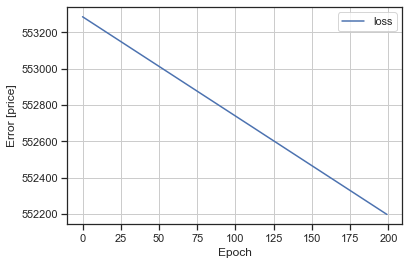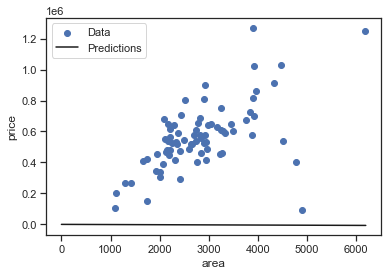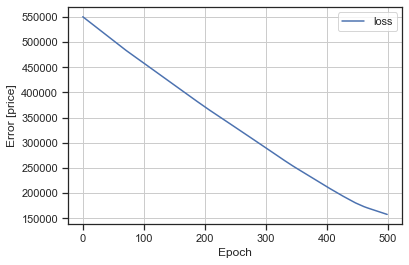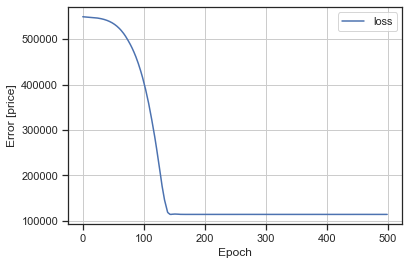TensorFlow
Contents
TensorFlow#
Case study: Houses for sale
Setup#
%matplotlib inline
import pandas as pd
import numpy as np
import seaborn as sns
import matplotlib.pyplot as plt
import tensorflow as tf
from tensorflow import keras
from tensorflow.keras import layers
from tensorflow.keras.layers.experimental import preprocessing
from sklearn.model_selection import train_test_split
from sklearn.metrics import r2_score
print(tf.__version__)
sns.set_theme(style="ticks", color_codes=True)
2.7.1
Data preparation#
See notebook “Data” for details about data preprocessing
from case_duke_data_prep import *
df.info()
<class 'pandas.core.frame.DataFrame'>
Int64Index: 97 entries, 0 to 97
Data columns (total 7 columns):
# Column Non-Null Count Dtype
--- ------ -------------- -----
0 price 97 non-null int64
1 bed 97 non-null int64
2 bath 97 non-null float64
3 area 97 non-null int64
4 year_built 97 non-null int64
5 cooling 97 non-null category
6 lot 97 non-null float64
dtypes: category(1), float64(2), int64(4)
memory usage: 5.5 KB
Simple regression#
We start with a single-variable linear regression, to predict price from area.
# Select features for simple regression
features = ['area']
X = df[features]
X.info()
print("Missing values:",X.isnull().any(axis = 1).sum())
# Create response
y = df["price"]
<class 'pandas.core.frame.DataFrame'>
Int64Index: 97 entries, 0 to 97
Data columns (total 1 columns):
# Column Non-Null Count Dtype
--- ------ -------------- -----
0 area 97 non-null int64
dtypes: int64(1)
memory usage: 1.5 KB
Missing values: 0
Data splitting#
# Train Test Split
# Use random_state to make this notebook's output identical at every run
X_train, X_test, y_train, y_test = train_test_split(X, y, test_size=0.2, random_state=42)
Linear regression#
Training a model with tf.keras typically starts by defining the model architecture.
In this case use a keras.Sequential model. This model represents a sequence of steps. In this case there is only one step:
Apply a linear transformation to produce 1 output using layers.Dense.
The number of inputs can either be set by the input_shape argument, or automatically when the model is run for the first time.
Build the sequential model:
lm = tf.keras.Sequential([
layers.Dense(units=1, input_shape=(1,))
])
lm.summary()
Model: "sequential_2"
_________________________________________________________________
Layer (type) Output Shape Param #
=================================================================
dense_2 (Dense) (None, 1) 2
=================================================================
Total params: 2
Trainable params: 2
Non-trainable params: 0
_________________________________________________________________
Once the model is built, configure the training procedure using the Model.compile() method.
The most important arguments to compile are the loss and the optimizer since these define what will be optimized (mean_absolute_error) and how (using the optimizers.Adam).
lm.compile(
optimizer=tf.optimizers.Adam(),
loss='mean_absolute_error'
)
Once the training is configured, use Model.fit() to execute the training:
%%time
history = lm.fit(
X_train, y_train,
epochs=200,
# suppress logging
verbose=0,
# Calculate validation results on 20% of the training data
validation_split = 0.2)
CPU times: user 4.63 s, sys: 386 ms, total: 5.01 s
Wall time: 5.39 s
y_train
49 525000
71 540000
69 105000
15 610000
39 535000
...
61 580000
72 650000
14 631500
93 541000
51 725000
Name: price, Length: 77, dtype: int64
# Calculate R squared
y_pred = lm.predict(X_train).astype(np.int64)
r2_score(y_train, y_pred)
-7.042298800162028
# slope coefficient
lm.layers[0].kernel
<tf.Variable 'dense_2/kernel:0' shape=(1, 1) dtype=float32, numpy=array([[-1.0806017]], dtype=float32)>
Visualize the model’s training progress using the stats stored in the history object.
hist = pd.DataFrame(history.history)
hist['epoch'] = history.epoch
hist.tail()
| loss | val_loss | epoch | |
|---|---|---|---|
| 195 | 552219.375 | 630846.2500 | 195 |
| 196 | 552213.875 | 630840.0000 | 196 |
| 197 | 552208.375 | 630833.6875 | 197 |
| 198 | 552202.875 | 630827.3750 | 198 |
| 199 | 552197.375 | 630821.0000 | 199 |
def plot_loss(history):
plt.plot(history.history['loss'], label='loss')
plt.xlabel('Epoch')
plt.ylabel('Error [price]')
plt.legend()
plt.grid(True)
plot_loss(history)

Collect the results (mean squared error) on the test set, for later:
test_results = {}
test_results['lm'] = lm.evaluate(
X_test,
y_test, verbose=0)
test_results
{'lm': 543700.625}
Since this is a single variable regression it’s easy to look at the model’s predictions as a function of the input:
x = tf.linspace(0.0, 6200, 6201)
y = lm.predict(x)
y
array([[ 3.9999834e-01],
[-6.8060338e-01],
[-1.7612051e+00],
...,
[-6.6971694e+03],
[-6.6982500e+03],
[-6.6993306e+03]], dtype=float32)
def plot_area(x, y):
plt.scatter(X_train['area'], y_train, label='Data')
plt.plot(x, y, color='k', label='Predictions')
plt.xlabel('area')
plt.ylabel('price')
plt.legend()
plot_area(x,y)

Multiple Regression#
# Select all relevant features
features= [
'bed',
'bath',
'area',
'year_built',
'cooling',
'lot'
]
X = df[features]
# Convert categorical to numeric
X = pd.get_dummies(X, columns=['cooling'], prefix='cooling', prefix_sep='_')
X.info()
print("Missing values:",X.isnull().any(axis = 1).sum())
# Create response
y = df["price"]
from sklearn.model_selection import train_test_split
# Train Test Split
# Use random_state to make this notebook's output identical at every run
X_train, X_test, y_train, y_test = train_test_split(X, y, test_size=0.2, random_state=42)
lm_2 = tf.keras.Sequential([
layers.Dense(units=1, input_shape=(7,))
])
lm_2.summary()
lm_2.compile(
optimizer=tf.optimizers.Adam(learning_rate=0.1),
loss='mean_absolute_error'
)
%%time
history = lm_2.fit(
X_train, y_train,
epochs=500,
# suppress logging
verbose=0,
# Calculate validation results on 20% of the training data
validation_split = 0.2
)
CPU times: user 6.7 s, sys: 430 ms, total: 7.13 s
Wall time: 6.52 s
# Calculate R squared
y_pred = lm_2.predict(X_train).astype(np.int64)
y_true = y_train.astype(np.int64)
r2_score(y_train, y_pred)
0.008066631014296388
# slope coefficients
lm_2.layers[0].kernel
<tf.Variable 'dense_14/kernel:0' shape=(7, 1) dtype=float32, numpy=
array([[93.865845],
[95.36067 ],
[93.04233 ],
[92.90618 ],
[95.016266],
[96.31462 ],
[87.34802 ]], dtype=float32)>
plot_loss(history)

test_results['lm_2'] = lm_2.evaluate(
X_test, y_test, verbose=0)
DNN regression#
This model will contain a few more layers than the previous model:
Two hidden, nonlinear, Dense layers using the relu nonlinearity.
A linear single-output layer.
dnn_model = keras.Sequential([
layers.Dense(units=1, input_shape=(7,)),
layers.Dense(64, activation='relu'),
layers.Dense(64, activation='relu'),
layers.Dense(1)
])
dnn_model.compile(loss='mean_absolute_error',
optimizer=tf.keras.optimizers.Adam(0.001))
%%time
history = dnn_model.fit(
X_train, y_train,
epochs=500,
verbose=0,
validation_split = 0.2)
CPU times: user 7.19 s, sys: 494 ms, total: 7.69 s
Wall time: 6.91 s
# Calculate R squared
y_pred = dnn_model.predict(X_train).astype(np.int64)
y_true = y_train.astype(np.int64)
r2_score(y_train, y_pred)
0.3319246298888
plot_loss(history)

test_results['dnn_model'] = dnn_model.evaluate(
X_test, y_test, verbose=0)
Performance comparison#
pd.DataFrame(test_results, index=['Mean absolute error [price]']).T
| Mean absolute error [price] | |
|---|---|
| lm | 537925.625000 |
| lm_2 | 145734.390625 |
| dnn_model | 103795.859375 |

